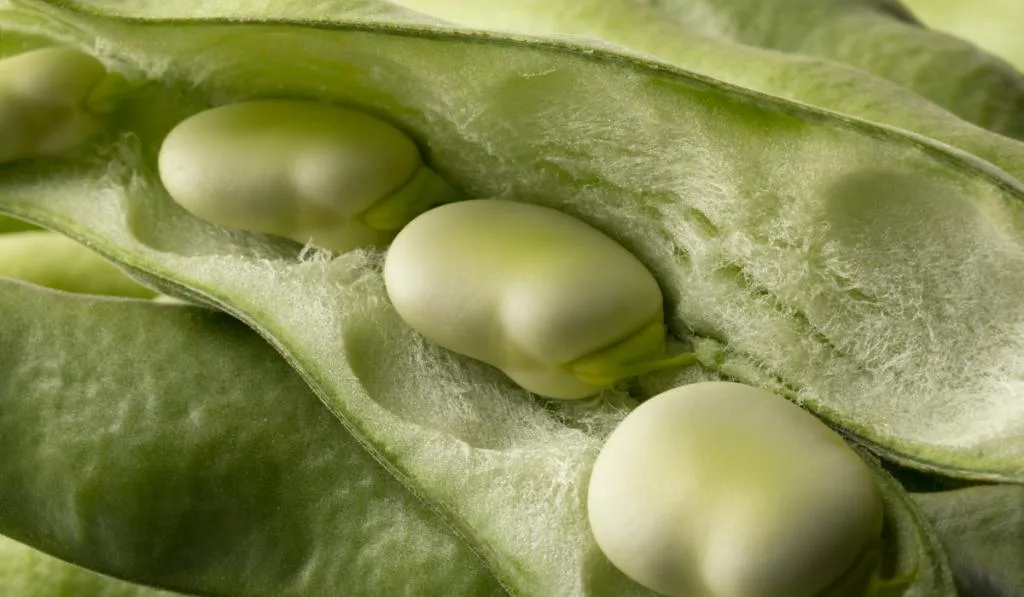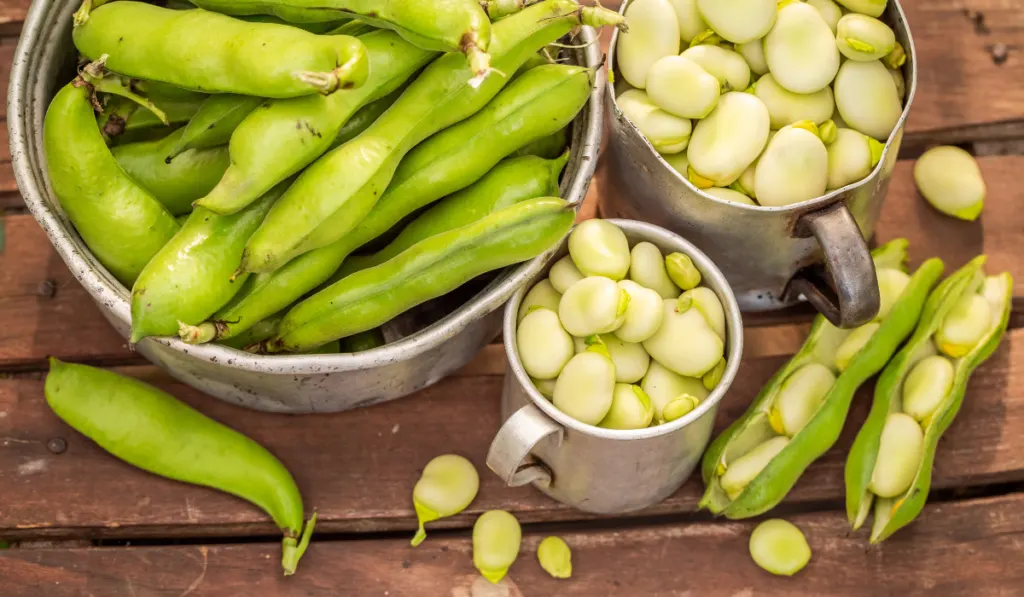Broad beans or fava beans are awesome legumes that people grow for many reasons, which usually depends on the type or variety of beans. Which type of fava beans should you grow? Read on to learn about the nine types of fava beans and which one suits your purposes.
Table of Contents
9 Types of Broad Beans
Here are the common types of fava beans that you can grow as well as some helpful information about them:

1. ‘Aguadulce’
This variety is also known as ‘Aguadulce.’ It produces 8 to 9-inch pods, each containing seven to eight tan-colored seeds. While you can grow it in multiple seasons, it is best grown in spring.
- Size: This variety can grow to reach 3-4 feet tall. It does not need extra growth support.
- Planting season and duration: Start this plant in spring and nurture it until it produces seeds in 90 days.
- Temperature hardiness: You can start it early; make sure the temperature does not fall below 15°F.
This variety is best grown and harvested for seeds because it produces a lot of sweet seeds for consumption.
2. ‘Diana’
The ‘Diana’ variety produces a lot of pods, and each pod can grow to be 3 to 4 inches long. This is a high-yielding variety, so gardeners grow it for its seeds and then use the spent plant as fodder for animals.
- Size: It can grow up to 3 feet tall so long as the right growing conditions are met.
- Planting season and duration: You can grow it in spring and fall. For spring, you can harvest it in 90 days. As for fall, you may need to wait up to 130 days.
- Temperature hardiness: This is a hardy variety that can grow in places with temperatures reaching 10°F.
This variety is best grown for its seeds as they are very delicious.

3. ‘Bell’
The ‘Bell’ fava bean variety is one that is best for planting as a cover crop or forage for livestock. It bears small seeds, so another name for it is a “small-seeded horse bean.” The little seeds discourage gardeners from growing them for food.
- Size: This variety grows very tall and can reach 2-5 feet in height. It can even surpass that when the growing conditions are optimal.
- Planting season and duration: Grow this variety in the fall so that you can use it as a cover crop to enrich the soil.
- Temperature hardiness: Though it is cold hardy, it does not tolerate low temperatures like others. Make sure that the temperature does not go below 25°F.
You do not need to wait until it produces seeds before you harvest it.
4. ‘Robin Hood’
This variety is grown for its seeds, but you can also use it as feed for livestock. While it produces a lot of pods, each containing 4-6 seeds. ‘Robin Hood’ does not require a lot of space and attention like other varieties.
- Size: This is a dwarf variety that can grow to reach 12-18 inches tall.
- Planting season and duration: If you start planting in spring, you can harvest the seeds in 90-100 days. You can start it very early.
- Temperature hardiness: While it can grow in cold regions, it does not grow as hardy as other plants. It would be best if you started it in spring when the temperature is above 20°F.
Feed the plants to your animals, such as cows and goats, immediately after you harvest the seeds.

5. ‘Sweet Lorane’
This is another cold-hardy variety you can grow as a cover crop or for its seeds. The seeds can be green, brown, or tan according to the growing condition and their stage of development. This variety resists many diseases and pests, so you can use it when practicing crop rotation.
- Size: It can grow to reach 1-1.5 feet tall. Just make sure that it receives enough sunlight.
- Planting season and duration: If you are growing it in spring, you will need 95 days before you can harvest the seeds. As for fall, however, it needs more than 130 days.
- Temperature hardiness: You can grow this variety at 10°F and above without mulch. With mulch, it can withstand down to 0°F.
You can harvest and eat the seeds raw. You do not even need to peel their skin because the skin is soft.
6. ‘Stereo’
The ‘Stereo’ fava bean is prized for its tender, immature pods. Each pod produces five seeds; you do not need to peel the skin because it is very tender. The immature seeds are delicious, even when eaten raw.
- Size: The plant can grow a little bit above 3 feet tall. It may grow slowly when you grow it in the fall.
- Planting season and duration: This variety is best grown in the spring months, and it needs only 95 days to produce sweet edible seeds.
- Temperature hardiness: Make sure that you grow ‘Stereo’ in temperatures higher than 20°F.
Try tasting the raw seeds and see how delicious they are.

7. ‘Crimson Flowered’
This variety is also known as ‘Crimson Flowering.’ It gets its name from the magenta blooms that attract pollinators. Grow this fava bean variety if you need pollinators in your garden, especially in spring. It also produces sweet and edible seeds.
- Size: It can grow to reach 3 feet tall. You can start the seeds compacted as they do not mind sharing space with others. This plant requires growth support such as a stake or trellis.
- Planting season and duration: You need up to 90 days before you can harvest the seeds in spring. In the fall, you need up to 160 days.
- Temperature hardiness: Ensure the temperature does not go below 15°F.
You will definitely enjoy the view of pollinators in your garden when you grow the ‘Crimson Flowering’ fava bean variety.
8. ‘Red Bristow’s’
This is a glorious heirloom variety that originates from Walgrave in Northamptonshire. It produces purple flowers, and the green pods turn purple when they ripen. The seeds of this variety are very delicious when young, so you do not need to cook them to enjoy them.
- Size: The plant can reach 4 feet tall so long as the temperature is just right.
- Planting season and duration: You need up to 100 days in spring to get the sweet seeds or 120 days in fall to get the fully ripened seeds.
- Temperature hardiness: While it is cold hardy, it is best grown in spring when the temperature is not lower than 20°F.
While you can wait until the seeds are fully mature before you harvest the plant, you can also harvest them before they turn red to enjoy their sweet taste.

9. ‘Purple Queen’ (Fava Mourda Reina Mouz)
If you are looking for a hardy variety, here it is. This variety is not just hardy but super delicious and has other purposes, such as a cover crop and fodder for animals. The color of the pods will change from green to purple when they are ripe and ready for harvesting.
- Size: It can reach 2-5 feet tall according to the growing conditions (light exposure).
- Planting season and duration: You can grow it in both spring and fall. Spring plants need up to 100 days, while fall plants can reach 160 days.
- Temperature hardiness: You can grow this plant in temperatures lower than 10°F. To help your plants, consider mulching them, especially in spring.
You do not need to cook the seeds before you enjoy them.
There are so many varieties that you can choose from. Which one will you grow?
Conclusion
Fava beans have a lot of uses, so you should grow them in your garden. It does not matter the season of the year; there is a fava bean variety right for you! Why not select a suitable type of fava bean from this article and start growing it right away?
